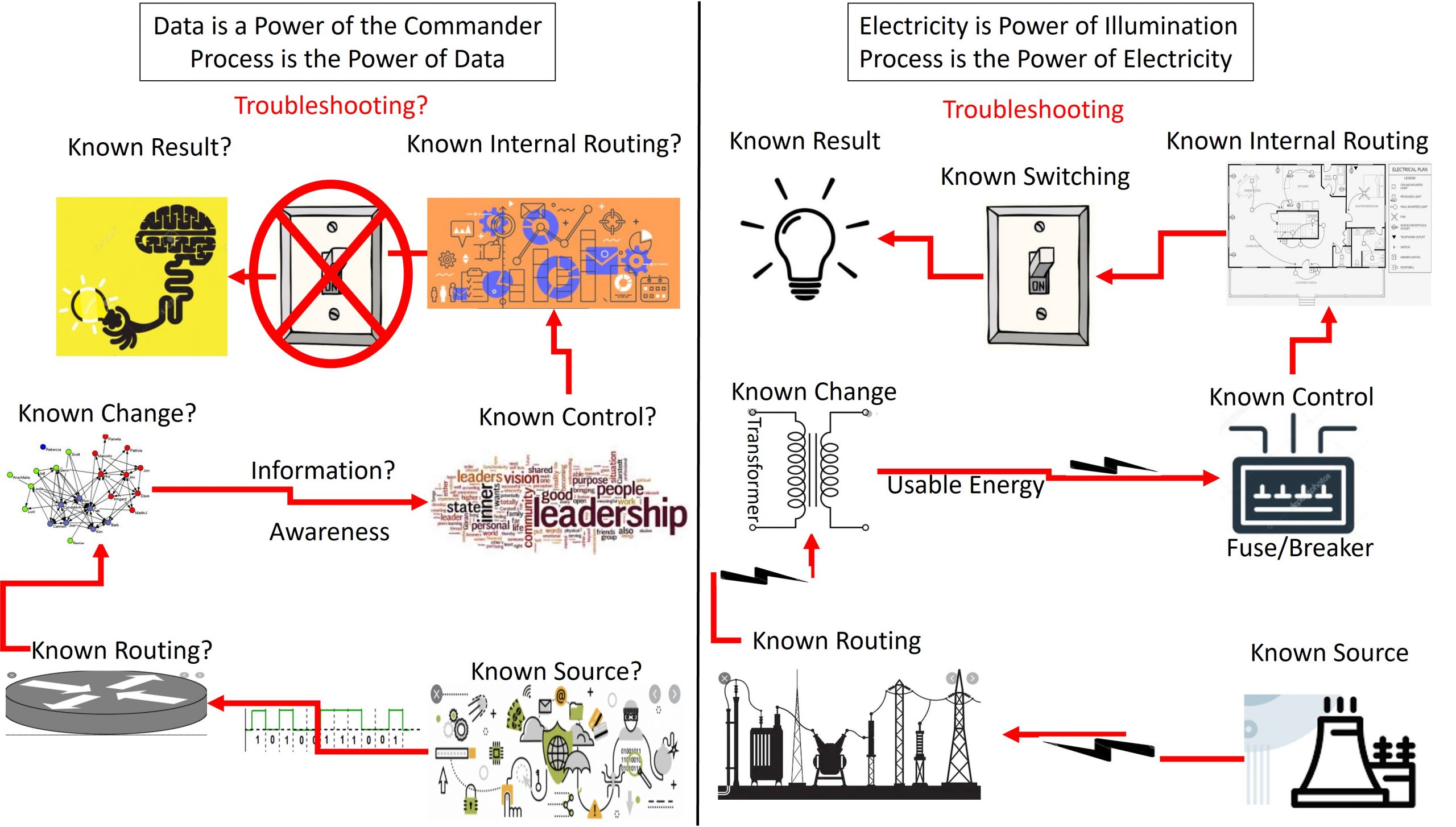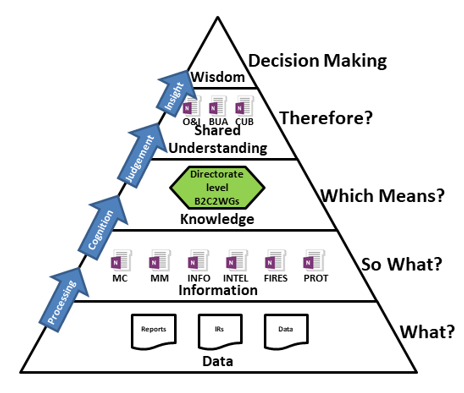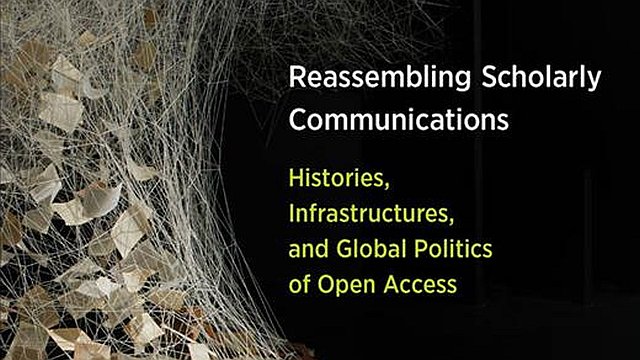
Understanding the nuanced power of data and electricity
To help a full understanding of the complex and complicated route that managed data must navigate, we have juxtaposed its course with a known scientific route – that of electricity. This enables a full grasp of the path that data takes to knowledge, in order to make decisions and assessments or facilitate learning as an organization.
It can’t be stressed enough that when observing data as a resource, without process, data has as much use as electricity does at its generation point. The major problem we have seen in knowledge management (KM), when looked at alongside this electron delivery model, is that effectively, the customer wants a light switch and has little regard for all that supports that switching function to produce light. This is a direct result of the “Google culture.”
Currently, in many cases, the result gained from the switch throw output still resembles the 1990s adage GIGO (garbage-in is garbage-out). This is a direct result of Google culture’s understanding of data management at the strategic and operational levels of the organization. It takes work by everyone. What follows is a description of the visualization in Figure 1, starting with having a known (data/power) source or not.

Known source
Electricity and electrons have a known and grounded source to draw. Data usually rides on and is stored with these electrons. However, the source of relevant data is not always apparent when building a knowledge-based system. Data can be good or bad, consistent with electrical spikes that could ruin electronics. Both sources are transmitted as the base element to be transformed later into something usable. In the case of electricity, the higher voltage allows for transmission. Throttling data is sometimes needed for transmission, and a result of understanding; too much is as bad as insufficient data. Outputs:
- Electricity – High voltage.
- Data – Unstructured data and possible unknown source.
Known routing
Where is the need for the resource? After settling the AC/DC wars between Tesla and Edison, the science, structure, installation, billing, and government control of routing electricity has been well established for over 240 years. Storing data for later use, routing data is often like mind reading when transmitting, but can be used effectively when executing a strategy if leadership has a strategy. More on leadership later. Discerning disinformation at this stage of data transmission. Outputs:
- Electricity – High voltage transmission near the point of need.
- Data – Stored (in or out of context) for later use somewhere. The data routing graphic used is technical, but this step also uses a process and will require people.
Known change
Change at this step is for usage throughout the next steps. In the electric model, this change is after high voltage transmission via a voltage reducing transformer, usually at the location of use; with data, this transformation is generally happening at the local area fused together based on the information requirement. Designing both to support the local area’s needs and long-distance multi-user transmission no longer needed in electricity, but could be used again with data. Outputs:
- Electricity – Usable household electricity.
- Data – Information, situational awareness. Again, must address the threat and credibility; disinformation.
Usable resource (flow)
At this point, the resource has undergone a process to make it functional in the local area. Both are inputs to the control of the next phase. It fuses electricity for downstream usage and safety, synthesizing information by leadership for understanding, direction, decisions, adaptability, and change. The mission command model supports the understand, visualize and describe aspects of that process. Later it supports the assessment phase of that cycle too.
Known control
Electricity has a fuse or breaker which limits damage to the downstream components and their surroundings in case of a mishap, spike, or unusual draw. Data must incorporate leadership to focus not only downstream but also upstream as per the strategy. Leadership must understand the only thing they can lead is change. They must be the change agents of data, information, content, and knowledge management, or this entire effort will be an exercise in futility. Both data and electric models have the capacity and resistance built in the form of capacitors, resistors, mission capacity, and late adopters. In the data model where the leader is in control, mission command focuses on the gained ability built through trust, command, and control, and tends to push the resistors forward through complete control. Outputs:
- Electricity – Safety and control.
- Data – Direction (downstream) and control (upstream).
Known internal routing
Known internal routing directs how the delivered usable resource gets to the exact point of need where it will be used – in electricity – displaying this in a schematic showing the path from control to usage point. In the data model, this could be a dashboard or repository, which is not necessarily along bureaucratic channels, but usually supports the need for knowledge in the local area. Outputs:
- Electricity – Internal routing of usable resources, troubleshooting.
- Data – Flattening and fusing the organization around information needs.
Known switching
The human interaction step of the delivered electricity. That electron that flowed from the source and was routed, changed into something usable, controlled, and routed again internally is now ready for the person’s decision to produce light, in this case for transparency. If all the previous steps are in order, there will be light and thus transparency. In our data model, there is no switch, even though many customers might believe there is or something similar to the movie Avatar’s Tree of Souls. It is submitting requests for trackers, dashboards, and content repositories without understanding the upstream process required for using data visualization, this cultural belief assumes installing these tools, like turning on a switch, will produce transparency. This belief is similar to installing a light switch at the point of need, disregarding how it is wired, or considering how the electricity got to the location. Outputs:
- Electricity – Physical action for the desired result.
- Data – Misnomer, there is no knowledge switch or Tree of Souls at this time.
Known result
With the electricity model, there is light at the point of need at the exact time when moving the switch to the on position. Achieving transparency is achieved because of all the upstream pieces and processes were in working order. In the data model, many want to have what is between the switch and result, and there is no switch in the data model. Like electricity, the data model will depend on all the upstream people, technical pieces, and processes being in working order. Results:
- Electricity – Light.
- Data – Situational understanding/misunderstanding depending on whether the upstream sources and components are collaborating on creation from awareness to understanding.
The ability to troubleshoot
What if something goes wrong? You must troubleshoot and correct the problem. In the scientific model of electricity, troubleshooting this complicated system is relatively easy. From the electrical / hydraulic / nuclear engineer, to the lineman and local electrician, each know their part of the system to produce the desired result of light. They have built-in monitoring systems and tools that can identify the problem 100% of the time and correct it in a reasonable period. The data model must incorporate the ability to troubleshoot the problem with operating procedures and business rules to support situational understanding. Missing this step, in a complex system, repairing or rebuilding is eliminated.
Two additional ways to visualize the concept


Conclusion
There is no knowledge switch. In all cases, the inputs to any technology are affecting the outputs. There is a direct coalition if one is flawed, then everything after that point will also be defective. In our case, the result of data is knowledge, electricity is light, and both request transparency. Both electricity and data reside on all steps, equipment, and people from the generation source, working together to produce the outcome desired. We are all searching for the knowledge switch, and at most, you can get information through artificial intelligence. This is due to the unlimited variables of how knowledge will be used and the gap between the science of management and the art of Leadership required in an unknown, unknowable, and constantly changing future – the new normal.
Acknowledgements: Thank you to John Antill for facilitating the submission of this article.
Header image source: PxHere and Febrian Eka Saputra on Pixabay, Public Domain.





